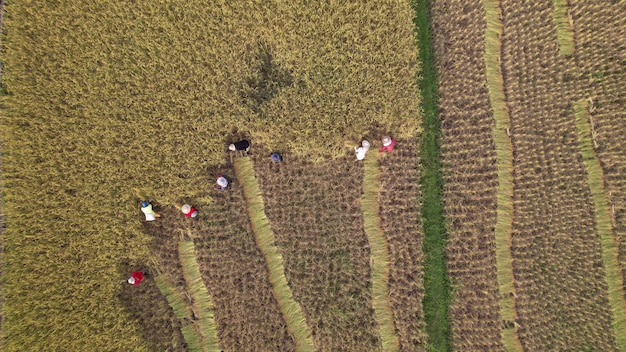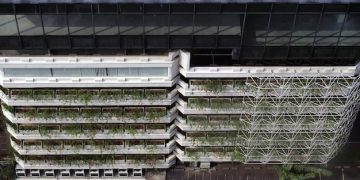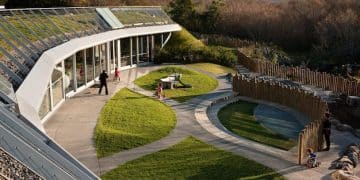Sustainable Agriculture: Mitigating Climate Change in the US with New Farming Practices

Sustainable agriculture in the US is crucial for mitigating climate change, employing innovative farming practices like precision agriculture, no-till farming, cover cropping, agroforestry, and integrated crop-livestock systems to reduce emissions and enhance carbon sequestration.
The agricultural sector significantly contributes to greenhouse gas emissions, but sustainable agriculture offers a promising path toward mitigating climate change in the US. Innovative farming practices are revolutionizing how we produce food while minimizing environmental impact.
The Urgency of Sustainable Agriculture in the US
Climate change poses a significant threat to global food security, and the agricultural sector is both a contributor and a potential solution. In the US, adopting sustainable agricultural practices is becoming increasingly urgent to reduce the environmental footprint of farming and enhance the resilience of food systems.
Transitioning to sustainable agriculture requires a fundamental shift in how we approach farming. It involves moving away from conventional, resource-intensive methods toward practices that prioritize soil health, biodiversity, and reduced reliance on synthetic inputs.
Impact of Conventional Farming
Conventional farming practices often rely heavily on synthetic fertilizers, pesticides, and intensive tillage, leading to soil degradation, water pollution, and greenhouse gas emissions. These practices can disrupt natural ecosystems and undermine the long-term productivity of agricultural lands.
Benefits of Sustainable Practices
Sustainable agriculture offers numerous benefits, including reduced greenhouse gas emissions, improved soil health, enhanced water quality, and increased biodiversity. By adopting these practices, farmers can contribute to climate change mitigation while also improving the resilience and profitability of their operations.

Sustainable agriculture, by focusing on soil enhancement and biodiversity, helps in creating healthy, resilient ecosystems that can better withstand the effects of climate change.
- Reduced greenhouse gas emissions through carbon sequestration in soil.
- Improved soil health leading to better crop yields and reduced need for fertilizers.
- Enhanced water quality by reducing runoff of pollutants.
- Increased biodiversity supporting a more resilient ecosystem.
Sustainable agriculture is not just about environmental conservation; it is also an economic opportunity for farmers. Healthier soils and more efficient resource management can lead to long-term cost savings and increased profitability.
In conclusion, the urgency of adopting sustainable agriculture in the US is driven by the need to mitigate climate change, protect natural resources, and ensure the long-term viability of food production. By embracing innovative farming practices, we can create a more sustainable and resilient agricultural system.
Precision Agriculture: Data-Driven Farming for Sustainability
Precision agriculture utilizes data and technology to optimize farming practices, reducing waste and improving efficiency. This approach allows farmers to tailor their inputs to the specific needs of their crops and soils, minimizing environmental impact and maximizing yields.
By leveraging data-driven insights, precision agriculture can help farmers make more informed decisions about irrigation, fertilization, and pest management, leading to more sustainable and profitable operations.
Role of Technology
Precision agriculture relies on various technologies, including GPS-guided machinery, remote sensing, and data analytics. These tools enable farmers to monitor crop conditions in real-time, identify areas of concern, and apply inputs precisely where they are needed.
Optimizing Resource Use
One of the key benefits of precision agriculture is its ability to optimize resource use. By applying fertilizers and pesticides only where they are needed, farmers can reduce waste, minimize environmental pollution, and save money on inputs.
By using precision agriculture methods, it’s possible to enhance sustainability by making informed decisions about the use of resources such as water and fertilizers.
- GPS-guided machinery for precise planting and harvesting.
- Remote sensing to monitor crop health and identify stress areas.
- Data analytics to optimize irrigation and fertilization.
- Variable rate application of inputs based on real-time needs.
Precision agriculture also enhances profitability by enhancing crop yields because resources are used efficiently and waste is reduced.

In conclusion, precision agriculture offers a powerful set of tools for promoting sustainable farming practices in the US. By leveraging data and technology, farmers can optimize resource use, reduce waste, and improve the resilience of their operations in the face of climate change.
No-Till Farming: Enhancing Soil Health and Carbon Sequestration
No-till farming is a conservation practice that involves planting crops directly into undisturbed soil, without tilling or plowing. This practice helps to improve soil health, reduce erosion, and enhance carbon sequestration, making it a valuable tool for mitigating climate change.
By minimizing soil disturbance, no-till farming promotes the development of healthy soil structure, which in turn supports better water infiltration, nutrient cycling, and carbon storage.
Benefits for Soil Health
No-till farming offers numerous benefits for soil health, including increased organic matter content, improved water infiltration, and reduced erosion. These benefits contribute to healthier, more resilient soils that can better support crop growth and withstand the impacts of climate change.
Carbon Sequestration Potential
One of the key advantages of no-till farming is its potential for carbon sequestration. By leaving crop residues on the soil surface, no-till farming promotes the accumulation of organic matter in the soil, which in turn sequesters carbon from the atmosphere.
By reducing the need for mechanical soil disturbance, soil health increases because the natural structure of the soil is mostly maintained, minimizing disruption.
- Reduced soil erosion improving water infiltration and keeping precious top soil.
- Increased organic matter enhancing beneficial soil microbes and carbon sequestration.
- Improved water infiltration helping water reach the roots of the crops.
- Enhanced nutrient cycling enabling efficient nutrient availability for the crops.
No-till farming is useful for farms facing economic challenges because it decreases the cost of fuel from the machinery. Additionally, soil degradation is decreased.
In conclusion, no-till farming is a valuable practice for enhancing soil health and mitigating climate change in the US. By minimizing soil disturbance and promoting carbon sequestration, farmers can improve the resilience of their operations and contribute to a more sustainable agricultural system.
Cover Cropping: Boosting Soil Fertility and Reducing Erosion
Cover cropping involves planting specific crops primarily for the benefit of the soil, rather than for harvest. These crops help to improve soil fertility, reduce erosion, and suppress weeds, making them a valuable tool for sustainable agriculture.
By providing a protective cover for the soil, cover crops help to prevent erosion, retain nutrients, and improve overall soil health. They also contribute to carbon sequestration and can reduce the need for synthetic fertilizers and herbicides.
Types of Cover Crops
There are many different types of cover crops, each with its own specific benefits. Common cover crops include legumes, grasses, and brassicas, which can be selected based on the specific needs of the soil and the cropping system.
Benefits for Crop Production
Cover crops offer numerous benefits for crop production, including improved soil fertility, reduced weed pressure, and enhanced water availability. By improving soil health, cover crops can lead to higher yields and reduced reliance on synthetic inputs.
Cover cropping plays an important role in soil productivity by enhancing the nitrogen availability and decreasing erosion.
- Improved soil fertility with added nitrogen from the planting of legumes.
- Reduced soil erosion because the cover crops act as living barricades.
- Suppressed weeds because the cover crops compete for nutrients.
- Enhanced water availability as the soil becomes better in infiltration.
Cover crops save farms money because they reduce the requirement for synthetic fertilizers and herbicides. This is done by decreasing the negative effects of chemical use in the environment.
In conclusion, cover cropping is a versatile and effective practice for boosting soil fertility and reducing erosion in agricultural systems. By selecting the right cover crops and managing them effectively, farmers can improve the health and productivity of their soils while also contributing to a more sustainable agricultural system.
Agroforestry: Integrating Trees into Farming Systems
Agroforestry is an integrated approach that combines trees and shrubs with crops and/or livestock in agricultural systems. This practice offers numerous benefits, including improved soil health, enhanced biodiversity, and climate change mitigation.
By integrating trees into farming systems, agroforestry creates more diverse and resilient landscapes that can provide a wide range of ecological and economic benefits. It also helps to sequester carbon and reduce greenhouse gas emissions.
Types of Agroforestry Systems
There are several different types of agroforestry systems, including alley cropping, silvopasture, and forest farming. Each system is designed to optimize the interactions between trees, crops, and livestock, maximizing the benefits for both the environment and the farmer.
Environmental and Economic Benefits
Agroforestry offers numerous environmental and economic benefits, including improved soil health, enhanced biodiversity, reduced erosion, and increased carbon sequestration. It can also provide additional income streams for farmers through the sale of timber, fruits, and other tree-based products.
Agroforestry offers various benefits that include soil enhancements and diverse support for wildlife.
- Improved soil health because trees add organic matter within the soil.
- Enhanced biodiversity supporting different species.
- Reduced erosion as the roots from the trees help keep the soil compacted.
- Economic benefits with an increased income from selling the timber from trees.
Agroforestry is a strategy to diversify the revenue stream and increase productivity for farmers.
In conclusion, agroforestry is a sustainable land management practice that offers numerous benefits for both the environment and the farmer. By integrating trees into agricultural systems, we can create more resilient and productive landscapes that contribute to climate change mitigation and biodiversity conservation.
Integrated Crop-Livestock Systems: Synergistic Farming for Sustainability
Integrated crop-livestock systems combine crop and livestock production on the same land, creating a synergistic relationship that enhances sustainability. This approach can improve soil health, reduce waste, and increase resource efficiency.
By integrating crops and livestock, farmers can create closed-loop systems that recycle nutrients, reduce reliance on synthetic inputs, and enhance the overall resilience of their operations.
Benefits of Integration
Integrated crop-livestock systems offer numerous benefits, including improved soil fertility, reduced pest and disease pressure, and enhanced nutrient cycling. Livestock can graze on crop residues, providing valuable forage while also returning nutrients to the soil through manure.
Reducing Waste and Enhancing Efficiency
One of the key advantages of integrated crop-livestock systems is their ability to reduce waste and enhance resource efficiency. Crop residues can be used as feed for livestock, while livestock manure can be used as fertilizer for crops, creating a closed-loop system that minimizes waste and maximizes resource utilization.
By integrating crop-livestock systems, resource inefficiencies are eliminated, thus creating synergistic sustainability.
- Improved soil fertility with the grazing of livestock and then waste in the soil.
- Reduced pest and disease pressure as the livestock can then keep things in check.
- Enhanced nutrient cycling with the livestock fertilizer which is of course all organic.
- Reduced waste as the livestock eat the crop residue, and the crops grow from livestock fertilizer.
Integrated crop-livestock systems reduce the reliance on synthetic inputs, such as fertilizers, due to the synergistic effects in the soil.
In conclusion, integrated crop-livestock systems are a sustainable farming approach that offers numerous benefits for both the environment and the farmer. By integrating crops and livestock, we can create more resilient and efficient agricultural systems that contribute to climate change mitigation and biodiversity conservation.
| Key Point | Brief Description |
|---|---|
| 🌱 No-Till Farming | Minimizes soil disturbance, enhancing carbon sequestration and soil health. |
| 🚜 Precision Agriculture | Uses data to optimize resource use, reducing waste and environmental impact. |
| 🌳 Agroforestry | Integrates trees with crops and livestock, improving biodiversity and carbon sequestration. |
| 🐮 Integrated Systems | Combines crop and livestock, reducing waste and enhancing sustainability. |
Frequently Asked Questions
▼
Sustainable agriculture is an approach to farming that focuses on long-term environmental health, economic profitability, and social equity. It prioritizes practices that minimize negative impacts on ecosystems and promote resilience.
▼
No-till farming reduces soil disturbance, which in turn enhances carbon sequestration in the soil. It also improves soil health and reduces erosion, contributing to a more sustainable agricultural system.
▼
Technology enables farmers to optimize resource use, reduce waste, and improve crop yields. Tools like GPS-guided machinery, remote sensing, and data analytics allow for precise management of inputs.
▼
Integrating trees into farming systems improves soil health, enhances biodiversity, and increases carbon sequestration. Agroforestry also provides additional income streams and promotes the resilience of agricultural landscapes.
▼
Integrated systems recycle nutrients, reduce reliance on synthetic inputs, and enhance overall resource efficiency. Livestock graze on crop residues, returning nutrients to the soil through manure: a virtuous cycle.
Conclusion
Adopting sustainable agriculture is essential for mitigating climate change in the US. New farming practices like precision agriculture, no-till farming, cover cropping, agroforestry, and integrated crop-livestock systems offer promising solutions for reducing emissions and enhancing carbon sequestration. By embracing these innovative approaches, farmers can contribute to a more sustainable and resilient future for agriculture.





